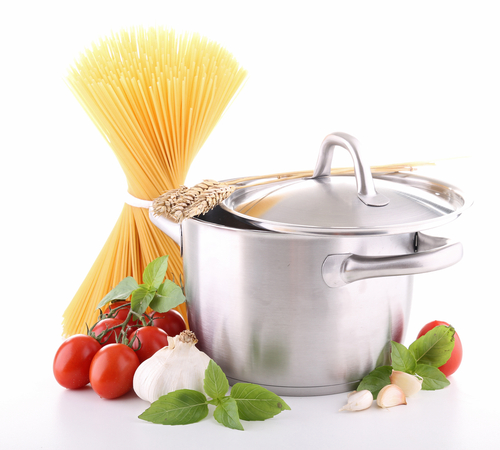Pasta Perfection

When cooking pasta, there a few guidelines you should follow each time you plan and prepare your meal to ensure the best results possible. Generally, you should first match the sauce to the pasta size and shape, although that is personal preference. For instance, I would choose a short, thicker pasta such as rigatoni, or a long pasta such as spaghetti or ziti for a heavy ragu` sauce, while a delicate creamy tomato sauce with baby shrimp would be ideal on angel hair pasta, or small shells. There are now many brands of dried pasta available, some good and others not so good, so I always choose a brand from Italy such as Barilla or de Cecco which are now widely available across North America. As for portion control, a general rule to remember is that you should use about 100 grams of dried pasta per person, 80 grams of fresh.
Now that you have chosen our sauce and pasta, and determined the quantity needed, it is time to start cooking. You should use a large pasta or stockpot that will hold 1 quart of water for every 100 grams of pasta used. Start with cold tap water as the hot water that has been sitting in the water heater loses it’s oxygen, leaving it flat. Bring the water to boil, then add about 1 teaspoon of salt per quart of water, or about 2 to 3 tablespoons for a large stockpot. Never add oil to your water as it makes the pasta slippery, preventing the sauce from adhering properly. Once the water is boiling rapidly, add the pasta and stir to prevent sticking. Follow package recommendations for cooking time, stirring every few minutes. Just before the suggested time is up, taste to determine if it is al dente. It should be cooked, but yet still firm to the teeth. Remember, the pasta will continue to cook a little after being removed from the heat. Never rinse the pasta after it has been cooked unless you are making a pasta salad as the starch left on the pasta after it cooks helps the sauce to adhere to it.
A good trick to remember is that before draining your pasta, take a small cup of the pasta water and set it aside. Then, once the sauce has been added to the pasta if it still seems a little dry, you can use the water to moisten it. Next you want to drain the pasta, but do not rinse unless you are planning to keep it at room temperature to be used in a salad, as the starch also helps the sauce adhere. Once it has been drained, return it to the pot over medium high heat with about one half of the sauce. Cook, stirring continuously for a minute or two. This is a trick used in restaurants, that both helps the sauce meld with the pasta, as well as ensure the dish will arrive at the table piping hot. Use the rest of the sauce on top of the pasta when serving. As a general rule when it comes to sauce, plan to use one to two tablespoons of a liquid sauce such as aglio olio, and at the most a quarter cup of a thicker sauce per person. The pasta should not be swimming in the sauce, nor should it be too dry. The sauce and pasta together should compliment each other and one should not stand out above the other.
As for grated cheese…..it really depends upon the sauce. Tomato, cream and meat-based sauces generally call for it while it is rarely offered for very spicy or fish-based sauces. If cheese is used though, it is served at the table, one or two teaspoons are sufficient, not a heavy dusting that overwhelms everything else so commonly seen here in North America.
Using these few hints will ensure that you too can prepare pasta to perfection!
Buon Appetito!
Deborah Mele 2011